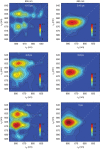Direct observation of multistep energy transfer in LHCII with fifth-order 3D electronic spectroscopy
- PMID: 26228055
- PMCID: PMC4532882
- DOI: 10.1038/ncomms8914
Direct observation of multistep energy transfer in LHCII with fifth-order 3D electronic spectroscopy
Abstract
During photosynthesis, sunlight is efficiently captured by light-harvesting complexes, and the excitation energy is then funneled towards the reaction centre. These photosynthetic excitation energy transfer (EET) pathways are complex and proceed in a multistep fashion. Ultrafast two-dimensional electronic spectroscopy (2DES) is an important tool to study EET processes in photosynthetic complexes. However, the multistep EET processes can only be indirectly inferred by correlating different cross peaks from a series of 2DES spectra. Here we directly observe multistep EET processes in LHCII using ultrafast fifth-order three-dimensional electronic spectroscopy (3DES). We measure cross peaks in 3DES spectra of LHCII that directly indicate energy transfer from excitons in the chlorophyll b (Chl b) manifold to the low-energy level chlorophyll a (Chl a) via mid-level Chl a energy states. This new spectroscopic technique allows scientists to move a step towards mapping the complete complex EET processes in photosynthetic systems.
Figures





References
-
- Jonas D. M. Two-dimensional femtosecond spectroscopy. Annu. Rev. Phys. Chem. 54, 425–463 (2003). - PubMed
-
- Cho M. Coherent two-dimensional optical spectroscopy. Chem. Rev. 108, 1331–1418 (2008). - PubMed
-
- Mukamel S., Tanimura Y. & Hamm P. Coherent multidimensional optical spectroscopy. Acc. Chem. Res. 42, 1207–1209 (2009). - PubMed
-
- Brixner T. et al.. Two-dimensional spectroscopy of electronic couplings in photosynthesis. Nature 434, 625–628 (2005). - PubMed
-
- Engel G. S. et al.. Evidence for wavelike energy transfer through quantum coherence in photosynthetic systems. Nature 446, 782–786 (2007). - PubMed
Publication types
LinkOut - more resources
Full Text Sources
Other Literature Sources

